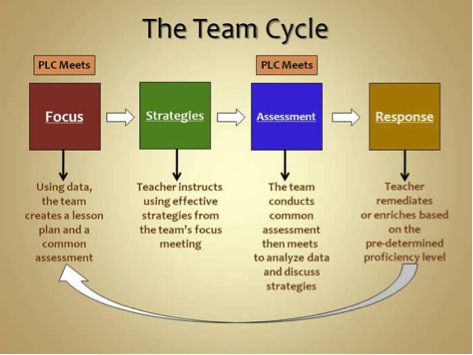What Is a Professional Learning Community?
A professional learning community (PLC) is an extended learning opportunity to foster collaborative learning among colleagues within a particular work environment or field. It is often used in schools as a way to organize teachers into working groups. Last year, West Branch Community School District organized PK-12 faculty into grade level PLC teams. Professional Learning Communities consist of three big ideas:
- Ensuring that students learn
- A culture of collaboration
- A focus on results
Big Idea #1: Ensuring That Students Learn
Professional Learning Communities shift the focus from teaching to a focus on learning. The heart of PLC’s are around the four questions:
- What do we want each student to learn?
- How will we know when each student has learned it?
- How will we respond when a student experiences difficulty in learning?
- How will we respond when a student has mastered the learning?
When teachers determine a student has difficulty, the professional learning community’s respond to the student need. The response needs to be:
- Timely
- Based on intervention rather than remediation. The plan provides students with help as soon as they experience difficulty rather than after they have failed
- Directive. Instead of inviting students to seek additional help, the systematic plan requires students to devote extra time and receive additional assistance until they have mastered the necessary concepts.
Big Idea #2: A Culture of Collaboration
Professional learning communities must work together to achieve their collective purpose of learning for all. PLC collaboration is a systematic approach in which teachers work together to analyze and improve classroom practice. Teams focus their efforts on the 4 guiding questions related to learning.
Big Idea #3: A Focus on Results
Professional learning communities work together to improve student achievement and this focus on results becomes the routine work of everyone in the school. Every teacher team participates in an ongoing process of identifying the current level of student achievement, establishing a goal to improve the current level, working together to achieve that goal, and providing periodic evidence of progress.
Why PLC?
Throughout the district, teachers are divided into 13 Grade Level PLC teams. Based upon the above guidelines, each team will complete 4-6 cycles per year. During professional development, teachers will collaborate weekly to monitor progress on the 4 guiding questions:
- What do we want each student to learn?
- How will we know when each student has learned it?
- How will we respond when a student experiences difficulty in learning?
- How will we respond when a student has mastered the learning?
Using this approach, teachers will collaborate to find strategies to improve and personalize learning for all students.
Below is a diagram of what a cycle looks like for each team.

References: DuFour, R (2004). What Is a “Professional Learning Community?.” Educational Leadership, 5-6.
